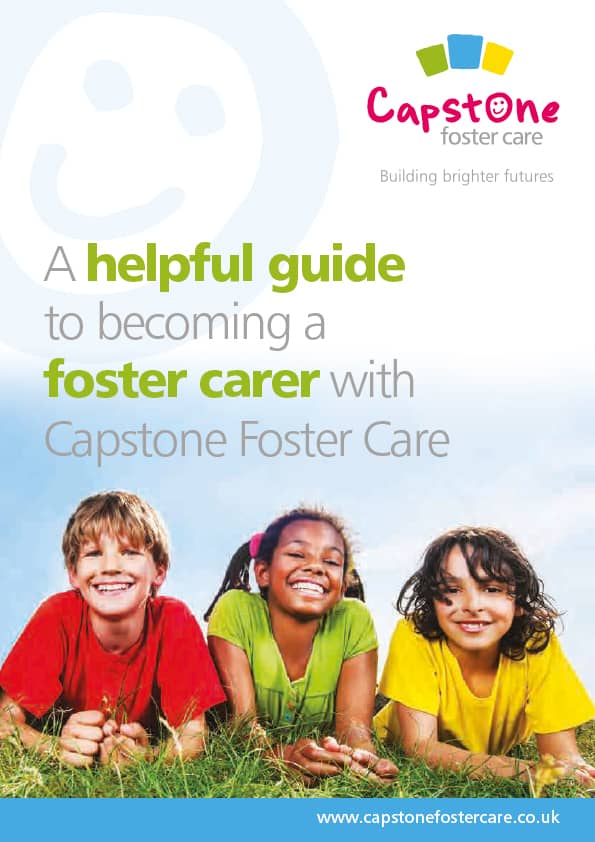


Fostering a disabled child
The role of an independent fostering agency
Can I choose who I foster?
How to foster
What are the benefits of fostering with an independent fostering agency?
What happens when a child is taken into care?
Fostering process: what happens on an initial home visit?
Can you foster if you have mental health issues?
Fostering with local authority vs independent agency
Interview: Life as a foster parent during the pandemic
Becoming A Foster Carer
Benefits of becoming a foster parent
What is a Care Leaver?
What is a Foster Carer?
What is Foster Care?
Do I become a Foster Carer?
Fostering Regulations
How much do Foster Parents get paid?
How to Foster a Child
How long does it take to become a Foster Carer?
How to foster – everything you ever wanted to know
Facts about Foster Care
What are the Foster Care requirements?
Foster Care Handbook
Foster Carer Job Description
Changing IFA - Transferring to Capstone
Fostering Definition
Foster Care Statistics
Fostering Assessment
Fostering Outcomes
Fostering Stories
Fostering Children UK
Children needing Fostering
8 reasons why a child may be taken into care
Fostering as a Career
Looked after Children
Top transferable job skills to become a foster carer
Fostering as a same sex couple
Fostering while renting
Can I foster if...?
Mythbusting the top 10 Foster Care Myths
Can I foster if I am disabled?
LGBT Fostering Mythbusting
Can I foster if I have pets?
Can I Foster A Child?
Can you Foster and Work?
Can you Foster with a Criminal Record
Fostering as a Single Parent
LGBT Family and Foster Care
Fostering across Cultures
Muslim Fostering
Christian Foster Care
Sikh
Empty Nest Syndrome and Foster Care
10 things you can do when your Children fly the nest
Can I Foster?
Fostering Babies - Myths
Focusing on Parent & Child Fostering
Fostering Siblings
Fostering Teenagers
Fostering Teenagers - Breaking down the Myths
Fostering Unaccompanied and Asylum Seeking Children
Mother and Baby Foster Placements
Private Fostering
Therapeutic Fostering - Multi-disciplinary Assessment Treatment & Therapy Service (MATTS)
Young Children Fostering Placements
Difference between short and long-term fostering
How to prepare a child for becoming a care leaver
Children who foster: impact of fostering on birth children
How to prepare your home for a foster child
10 tips for foster children’s education
How to prepare your foster child for secondary school
Tips for coping when foster placements end
Tips for foster parents during Coronavirus
What happens if foster parents get divorced?
5 ways to manage Mother’s Day with foster children
Tips for managing foster children’s bedtime routines
How to handle foster child bullying
Fostering allowances and the gender pay gap
Tips for keeping foster children safe online
How to adopt from Foster Care
5 ways to manage Father’s Day with foster children
8 most common fostering challenges
Supporting foster children’s contact with birth families
How to deal with empty nest syndrome
How to recognise signs of depression in foster children
Can you take a foster child on holiday?
Tips and advice on fostering with a disability
10 tips on connecting with your Foster Child
Fostering versus Adoption - What's the difference?
How Fostering can change a future
How to adopt from Foster Care
How to encourage children to read in Foster Care
How to prepare a Foster Child's bedroom
Online grooming - unwanted contact and how to identify it
Reading and storytelling with Babies and young Children
Supporting Children's Learning
Technology and Internet Safety advice
The 20 most recommended books Foster Carers and young people should read
The impact of early childhood traumas on adolescence and adulthood
Tips for coping with attachment disorders in Foster Children
Tips for supporting reunification in Foster Care
Together for a better Internet - Web Safety for Foster Children
What is sexual abuse and sexual violence
Foster Child behaviour management strategies
Foster Parent Advice: What to expect in your first year of fostering
Capstone's twelve tips at Christmas
10 celebrities who grew up in Foster Care
Celebrating our Children and Young People
Could Millenials be the solution to the Foster Care crisis?
Do you work in Emergency Services?
Form F Assessor and Assessment Training
Foster Care Fortnight
Improving Children's Welfare - Celebrating Universal Children's Day
It's time to talk about Mental Health and Foster Care
New Year - New Career - Become a Foster Carer
Promoting the rights and wellbeing of persons with Disabilities
Refugee Week
Young people and Mental Health in a changing world
Young People Charities
As well as ensuring they are in a safe, secure, loving environment, protecting your foster child’s online safety is a large part of caring for a child during a foster placement. In this modern age where technology is everywhere, continually expanding and providing new opportunities for communication at any time, this can pose its challenges to managing foster children, and ensuring they are safe.
Below we’ve listed the top dangers for foster children online, and tips for foster parents on how to prevent these risks from becoming a reality.
One of the biggest potential dangers of a foster child’s online safety is the risk of grooming. Grooming refers to when an adult creates an emotional connection with a child with unacceptable goals in mind. They will often resort to creating this connection by means of flattery, bribes, intimidation, using authoritative power or other methods. This sort of attention online can lead foster children into dangerous situations where they could feel trapped, scared, embarrassed or alone.
Tips: communicating is key. Your foster child needs to be educated on the dangers of online grooming, how to spot the signs that they are being groomed, and what they should do if they think they are. It’s also important to keep open the lines of communication about their day-to-day – including any family issues, problems at school, etc – as these are the sort of problems predators use to find a way into their personal lives. Learn more about grooming and how to identify it now.
Unfortunately, one of the most common forms of child bullying comes in the form of cyber bullying. Without the understanding of how to keep their online space personal and private, your foster child may be subjected to online bullying that they can’t escape from – and this can often be an extension of offline bullying in a peer group.
Tips: if you believe your foster child is being bullied online, the first port of call is to speak to your foster child about it, and involve their social worker. You should raise your concerns with your own supervising social worker, and ensure your child knows that they are not online in their situation. If the bullying is occurring as a by-product from school, or a social environment, it might also be useful to speak to an authoritative adult. You should also educate your child on privacy settings of social media platforms – for example, making their profile private, and unfollowing/blocking anyone who is bullying them online, or restricting what is visible.
Without proper education in handling themselves online, your foster children could accidentally run into security issues, for example, identify theft, using unsecure passwords and keeping profiles public, which leads to an invasion of privacy. This could also come in the form of phishing – which is when a cyber security professional uses email predominantly, or another communication platform, to try and trick the recipient into clicking on links. These are often spam links – which could then lead to many complications, such as viruses on your software.
Tips: inform your foster child about the risks of phishing scams by showing them how they can check if an email address is legitimate, and educate them on ensuring they are not revealing personal information on any sites.
As is the case with many celebrities, public figures or any person of interest, the history of your social media platforms can be sometimes thoroughly investigated later in life. That’s where lies the problem with children using the internet from a young age, and not understanding what is appropriate to post, and what’s not. For example, an offensive post (e.g., racist, sexist, homophobic) may not be fully understood at a young age but, once published, could come back to haunt them in later life.
Tips: ensure your foster child knows that whatever they post on the internet cannot be undone – so they need to be extremely mindful about what they are putting out there, whether that be a home address for security purposes, or an offensive post. It’s also wise to encourage them not to partake in cyber bullying themselves at the emotional harm of another person, or online trolling.
If you’re fostering teenagers, it might be more likely that they are curious about what can be found on the internet, and exposing themselves to content which is inappropriate and shouldn’t be viewed. This could include pornography, extreme violence or any other forms of content which is deemed as unacceptable for a child to view.
Tips: you can set up child protection software on your computer which means you have more control of the sites that they are looking at. Keeping your computer/laptop in a communal area of the house would also likely eliminate the possibility of them actively seeking any inappropriate content.
Managing the relationship between your foster child and their biological family can be challenging – but that can be made especially tricky when social media comes into play, as it then becomes very easy for either person to reach out. A child’s care plan outlines the level of contact that should be maintained between a foster child and their birth family, so having technology involved can often disrupt that.
Tips: manage this carefully with your supervising social worker, and the child’s social worker. The child’s care plan is set in place for a reason – so it’s important the level of contact is maintained throughout the placement. If this is not being met by the biological family, this could affect their ability for reunification in some instances – but the foster child also needs to know what is an appropriate level of contact, and what is not.
For more information on technology and internet safety for foster children, contact a member of our helpful team for advice and support.
If you’ve got any questions or would like to find out more about fostering with Capstone, fill out the form below.
An experienced fostering advisor from your local area will then be in touch.

Start the conversation today. Our team of friendly advisors are on hand to answer any foster care questions you may have. We can offer you honest and practical advice that can help you decide if becoming a foster carer is the right path for you.


